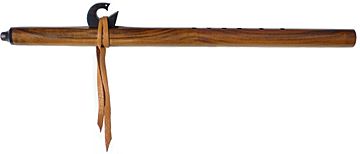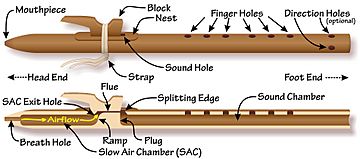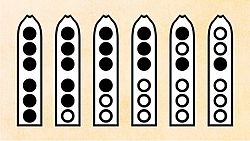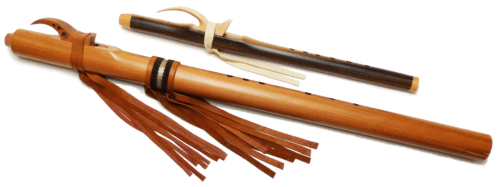Native American flute facts for kids
The Native American flute is a flute that is held in front of the person playing it, has open holes for the player's fingers, and has two separate parts: one for the breath of the person playing the flute and another that makes the sound of the flute.
The player breathes into one end of the flute. A block on the outside of the flute directs the player's breath from the first part to the second part, causing air to vibrate in the second part. The vibration causes a steady resonance of air in the second part that creates sound.
Native American flutes are made in many different designs, sizes, and variations — far more other woodwind instruments.
Contents
Names
The Native American flute has many other names.: American Indian courting flute, courting flute, Grandfather's flute, Indian flute, love flute, Native American courting flute, Native American love flute, Native American style flute (see the Indian Arts And Crafts Act), North American flute, Plains flute, and Plains Indian courting flute.
The correct way to spell the name of the instrument is "Native American flute" using capital letters for "N" and "A" and lower-case letters for the "f" in "flute".
A person who plays Native American flutes is called a "flutist". The word "flautist" is used, but much less often.
History
There are many stories about how different Native American peoples invented the Native American flute. In one story, a woodpecker pecked holes in the branch of a tree while searching for termites. When the wind blew along the holes, people heard music.
It is not well known how the design of the Native American flute developed before 1823. Some of the influences may have been:
- Branches of trees or stalks of plants with holes drilled by insects that created sounds when the wind blew.
- The atlatl.
- Musical instruments made of clay made in Mesoamerica.
- The Anasazi flute, a type of flute developed by early Native American peoples.
- The parts of the organ that make the sound of the instrument. Native Americans were taught to make these parts of the organ as early as 1524.
- The recorder — a musical instrument that came from Europe.
It is also possible that instruments were carried from other cultures during migrations.
The oldest Native American flute made of wood is from 1823. It is now in a museum in Bergamo, Italy.
Parts
The Native American flute has two parts: the slow air chamber and the sound chamber. A plug inside the instrument separates the slow air chamber from the sound chamber.
The parts of the Native American flute can have many alternate names. The plug is sometimes called the internal wall. The slow air chamber is also called the "SAC", the compression chamber, or the mouth chamber. The sound chamber is also called the pipe body, the playing chamber, the resonating chamber, the tone chamber, or the variable tube.
The block on the outside of the instrument is a separate part that can be removed. The block is also called the bird, the saddle, or the totem. The block is tied by a strap onto the nest of the flute. The block moves air through a flue from the slow air chamber to the sound chamber. The block is often in the shape of a bird.
The slow air chamber has a mouthpiece and breath hole for the player's breath. Air flows through the slow air chamber and up the exit hole into the flue.
The sound chamber contains the sound hole, which creates the vibration of air that causes sound when the airflow reaches the splitting edge. The sound hole can also be called the whistle hole, the window, or the true sound hole ("TSH"). The splitting edge can also be called the cutting edge, the fipple edge, the labium, or the sound edge.
The sound chamber also has finger holes that allows the player to change the frequency of the vibrating air. Changing the frequency of the vibration changes the pitch of the sound produced.
The finger holes on a Native American flute are open, meaning that fingers of the player cover the finger hole (rather than metal levers or pads such as those on a clarinet). This means that the player must be able to reach all the finger holes on the instrument with their fingers. The finger holes can also be called the note holes, the playing holes, the tone holes, or the stops.
The foot end of the flute — the end far away from the player's mouth — can have direction holes. These holes affect the pitch of the flute when all the finger holes are covered. They also relate to the "Four Directions" of East, South, West, and North found in many Native American stories. The direction holes can also be called the tuning holes or wind holes.
The picture shown above – Parts of the Native American flute with English-language labels – can also be seen with labels in Cherokee, Dutch, Esperanto, French, German, Japanese, Korean, Polish, Russian, and Spanish.
Spacer Plate
Another way to build Native American flutes uses a spacer plate to create the flue. The spacer plate sits between the nest area on the body of the flute and the block. The spacer player is usually held in place by the same strap that holds the block onto the instrument. The splitting edge can also be part of the spacer plate.
The spacer plate is often made of metal, but spacer plates can be made of wood, bark, and ceramic.
Dimensions
Many old Native American flutes were made using measurements of the body. The length of the flute was the distance from inside of the elbow to tip of the index finger. The length of the slow air chamber was the width of the fist. The distance between the sound hole and first finger hole was the width of the fist. The distance between finger holes would be the width of a thumb. The distance from the last finger hole to the end of the flute was the width of the fist.
Currently, makers of Native American flutes use many methods to design the dimensions of their flutes. This is very important for the location of the finger holes, since they control the pitch of the different notes of the instrument. Flute makers may use calculators to design their instruments, or use dimensions provided by other flute makers.
Materials
Many Native American flutes are made from river cane, bamboo, wood, or even plastic. Some makers of Native American flutes use ceramic or glass.
Music
Many Native American flutes have a musical scale called the pentatonic scale in a minor key. This musical scale is used in most Native American flute music. However, some makers of Native American flute now use different musical scales. Also, many makers of Native American flutes tune flutes carefully so that they sound good when played with other instruments such as guitars and pianos.
Native American flutes may be large or small and have a wide range from very low notes to very high notes. From the largest flutes (lowest pitch) to the smallest flutes (highest pitch), they span a range of about three and a half octaves, from C2 to A5.
Early recordings of Native American flutes are available from several sources.
Fingering
Most Native American flutes have either five finger holes or six finger holes. However, a flute may have no finger holes or as many as seven finger holes, including a hole for the thumb. Different makers employ different musical scales and fingerings for their flutes.
Written Music
Written music for the Native American flutes is often in the key of F-sharp minor, although some music is scored in other keys. However, music written for the Native American flute uses a key signature of four sharps. This is known as "Nakai tablature". Many pieces of written music adds finger diagrams below the notes to show which finger holes to cover for that note.
The use of a standard key signature for written music that can be used across Native American flutes in a variety of keys classifies the instrument as a transposing instrument.
Revival

There were few Native American flute players before 1960. However, use of the Native American flute increased in the late 1960s. Many people began playing Native American flutes, such as Doc Tate Nevaquaya, John Rainer, Jr., Sky Walkinstik Man Alone, and Carl Running Deer.
The music of R. Carlos Nakai became popular in the 1980s. The album "Canyon Trilogy" was issued in 1989. In 1998 it was the first Native American music album certified as a Gold Record by the Recording Industry Association of America. Canyon Trilogy was certified as a Platinum Record on July 8, 2014.
Mary Youngblood won two Grammy Awards in the Native American Music category for her Native American flute music in 2002 and 2006. Today, Native American flutes are being played and recognized by many different peoples and cultures around the world.
Community Music
Groups of players of the Native American flute meet every month or two. These groups are known as flute circles.
These organizations help flute circles within their country:
Images for kids
-
Flute of the Akimel O'odham culture. The bottom flute demonstrates the use of a "cloth or ribbon" over the center of the flute to serve as a block. Russell specifically notes that the bottom-most flute "has an old pale yellow necktie tied around the middle as an ornament and to direct the air past the diaphragm."












